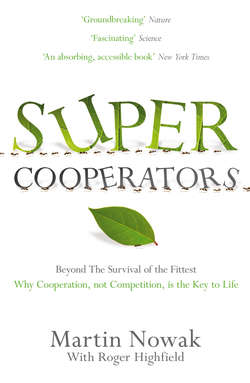Читать книгу SuperCooperators - Roger Highfield - Страница 13
На сайте Литреса книга снята с продажи.
INCARCERATION
ОглавлениеOn my first encounter with the Prisoner’s Dilemma in that Alpine hut, I was transfixed. By that time, Karl had actually become my prisoner. He didn’t have any transport and I offered him a ride back to Vienna. We discussed the Dilemma as we drove back the next day in the same VW that my father still uses today to putter around Austria. Even after I dropped Karl off, I kept him in my sights. Before long, I was doing a PhD with him at the Institute for Mathematics in Vienna. Students who had studied there before me include the great physicist Ludwig Boltzmann, the logician Kurt Gödel, and the father of genetics, Gregor Mendel.
As I pursued my doctorate, Karl and I would often meet in local coffeehouses, the genius loci of past glory. In these inspiring surroundings Gödel had announced his incompleteness theorem, Boltzmann had worked on entropy, and Wittgenstein had challenged the Vienna Circle, a group of intellectuals who would gather to discuss mathematics and philosophy. One day we sat in the Café Central, an imposing building with arched ceilings and marble columns, where Trotsky had planned the Russian revolution.
As we sipped thick, strong coffee and chatted about how to solve the Prisoner’s Dilemma, Karl and I rediscovered the subtleties of a problem that had transfixed bright minds for generations. Little did we realize that in the decades that followed, we would devise new mathematics to explore the Dilemma. We would create communities of agents in a computer, study how they evolved, and conduct analyses to reveal the mechanisms able to solve the Dilemma. I would establish teams at Oxford, Princeton, and Harvard as well as collaborations with mathematicians, biologists, chemists, doctors, and economists around the world to understand how these mechanisms worked and what their wider implications were.
Some scientists regard the Prisoner’s Dilemma as a remarkably revealing metaphor of biological behavior, evolution, and life. Others regard it as far too simple to take into account all the subtle forces at play in real societies and in biology. I agree with both camps. The Dilemma is not itself the key to understanding life. For the Dilemma to tell us something useful about the biological world, we need to place it in the context of evolution.
Evolution can only take place in populations of reproducing individuals. In these populations, mistakes in reproduction lead to mutation. The resulting mutants might reproduce at different rates, as one mutant does better in one environment than another. And reproduction at different rates leads to selection—the faster-reproducing individuals are selected and thrive. In this context we can think about the payouts of the Prisoner’s Dilemma in terms of what evolutionary scientists call “fitness” (think of it as the rate of reproduction). Now we can express what cooperation in the Prisoner’s Dilemma means when placed in an evolutionary context: if I help you then I lower my fitness and increase your fitness.
Here’s where the story gets fascinating. Now that we have put the Dilemma in an evolutionary form, we discover that there is a fundamental problem. Natural selection actually opposes cooperation in a basic Prisoner’s Dilemma. At its heart, natural selection undermines our ability to work together. Why is this? Because in what mathematicians call a well-mixed population, where any two individuals meet equally often, cooperators always have a lower fitness than defectors—they’re always less likely to survive. As they die off, natural selection will slowly increase the number of defectors until all the cooperators have been exterminated. This is striking because a population consisting entirely of cooperators has a higher average fitness than a population made entirely of defectors. Natural selection actually destroys what would be best for the entire population. Natural selection undermines the greater good.
To favor cooperation, natural selection needs help in the form of mechanisms for the evolution of cooperation. We know such mechanisms exist because all around us is abundant evidence that it does pay to cooperate, from the towering termite mound to the stadium rock concert to the surge of commuters in and out of a city during a working day. In reality, evolution has used these various mechanisms to overcome the limitations of natural selection. Over the millennia they have shaped genetic evolution, in cells or microbes or animals. Nature smiles on cooperation.
These mechanisms of cooperation shape cultural evolution too, the patterns of change in how we behave, the things we wear, what we say, the art we produce, and so on. This aspect of evolution is more familiar: when we learn from each other and alter the way we act accordingly. It also takes place over much shorter timescales. Think about a population of humans in which people learn different strategies to cope with the world around them, whether religion or boat building or hammering a nail into a piece of wood. The impact of cooperation on culture is huge and, for me, the central reason why life is so beguiling and beautiful.
